A Comparative Study of a Deep Reinforcement Learning Solution and Alternative Deep Learning Models for Wildfire Prediction
Abstract
1. Introduction
- Develop and implement a DRL-based Actor–Critic model for wildfire prediction using historical environmental data.
- Compare the performance of DRL models with traditional deep learning approaches, including CNNs and Transformer-based architectures.
- Analyze the impact of different environmental features (temperature, wind speed, vegetation type, and topography) on wildfire occurrences using feature importance analysis.
- Propose a practical framework for integrating DRL models into operational wildfire management systems, to enhance predictive accuracy and decision-making capabilities.
2. Background
2.1. Machine Learning
2.2. Deep Learning
2.3. Deep Reinforcement Learning
3. Dataset Overview
3.1. Feature Description
3.2. Target Variable
- : Lower probability, indicating minimal wildfire risk.
- : Higher probability, suggesting an increased likelihood of wildfire occurrence.
3.3. Addressing Dataset Imbalance
- Synthetic Data Generation: Creating artificial samples to simulate low-risk conditions where wildfires did not occur.
- Probabilistic Labeling: Assigning probabilistic values to real and synthetic samples to reflect the spectrum of fire risk scenarios.
- Feature Normalization: Standardizing numerical attributes to ensure uniformity across scales, facilitating model convergence.
3.4. Optimal Modeling Approach
4. Materials and Methods
4.1. Actor–Critic Training for Wildfire Prediction
4.2. CNN Training for Wildfire Prediction
4.3. Transformer Training for Wildfire Prediction
5. Results and Discussion
5.1. Accuracy Analysis
5.2. Validation Performance Analysis
5.3. Precision and Recall
5.4. F1-Score Analysis
5.5. AUC-ROC Performance
5.6. Feature Importance Analysis
- Temperature (°C): Higher temperatures strongly correlated with increased wildfire risk.
- Relative Humidity (%): Inversely related to wildfire probability, with lower humidity contributing to drier conditions.
- Wind Speed (m/s): Strong winds facilitated fire spread, making this a crucial factor in predictions.
- Vegetation Type: Certain vegetation categories (e.g., dense forests, shrublands) exhibited higher susceptibility to ignition.
- Urban-Rural Interface (IUR): Areas closer to human settlements had higher fire occurrences, likely due to anthropogenic factors.
5.7. Discussion
6. Conclusions
Supplementary Materials
Author Contributions
Funding
Informed Consent Statement
Data Availability Statement
Acknowledgments
Conflicts of Interest
References
- Richardson, D.; Black, A.S.; Irving, D.; Matear, R.J.; Monselesan, D.P.; Risbey, J.S.; Squire, D.T.; Tozer, C.R. Global Increase in Wildfire Potential from Compound Fire Weather and Drought. Npj Clim. Atmos. Sci. 2022, 5, 23. [Google Scholar] [CrossRef]
- Duane, A.; Castellnou, M.; Brotons, L. Towards a Comprehensive Look at Global Drivers of Novel Extreme Wildfire Events. Clim. Change 2021, 165, 43. [Google Scholar] [CrossRef]
- Villagra, P.; Paula, S. Wildfire Management in Chile: Increasing Risks Call for More Resilient Communities. Environ. Sci. Policy Sustain. Dev. 2021, 63, 4–14. [Google Scholar] [CrossRef]
- Aguirre, P.; León, J.; González-Mathiesen, C.; Román, R.; Penas, M.; Ogueda, A. Modelling the vulnerability of urban settings to wildland–urban interface fires in Chile. Nat. Hazards Earth Syst. Sci. 2024, 24, 1521–1537. [Google Scholar] [CrossRef]
- Bhowmik, R.T.; Jung, Y.S.; Aguilera, J.A.; Prunicki, M.; Nadeau, K. A multi-modal wildfire prediction and early-warning system based on a novel machine learning framework. J. Environ. Manag. 2023, 341, 117908. [Google Scholar] [CrossRef]
- Bot, K.; Borges, J.G. A Systematic Review of Applications of Machine Learning Techniques for Wildfire Management Decision Support. Inventions 2022, 7, 15. [Google Scholar] [CrossRef]
- Singh, H.; Ang, L.M.; Lewis, T.; Paudyal, D.; Acuna, M.; Srivastava, P.K.; Srivastava, S.K. Trending and Emerging Prospects of Physics-Based and ML-Based Wildfire Spread Models: A Comprehensive Review. J. For. Res. 2024, 35, 135. [Google Scholar] [CrossRef]
- Marjani, M.; Mahdianpari, M.; Mohammadimanesh, F. CNN-BiLSTM: A Novel Deep Learning Model for Near-Real-Time Daily Wildfire Spread Prediction. Remote Sens. 2024, 16, 1467. [Google Scholar] [CrossRef]
- Carta, F.; Zidda, C.; Putzu, M.; Loru, D.; Anedda, M.; Giusto, D. Advancements in Forest Fire Prevention: A Comprehensive Survey. Sensors 2023, 23, 6635. [Google Scholar] [CrossRef]
- Gautam, M. Deep Reinforcement Learning for Resilient Power and Energy Systems: Progress, Prospects, and Future Avenues. Electricity 2023, 4, 336–380. [Google Scholar] [CrossRef]
- Tupayachi, J.; Ferguson, M.M.; Li, X. A Simulation-Based Real-Time Deep Reinforcement Learning Approach for Fighting Wildfires. In Proceedings of the 2024 Annual Modeling and Simulation Conference (ANNSIM), Washington, DC, USA, 20–23 May 2024; pp. 1–12. [Google Scholar] [CrossRef]
- Altamimi, A.; Lagoa, C.; Borges, J.G.; McDill, M.E.; Andriotis, C.P.; Papakonstantinou, K.G. Large-Scale Wildfire Mitigation Through Deep Reinforcement Learning. Front. For. Glob. Change 2022, 5, 734330. [Google Scholar] [CrossRef]
- McWethy, D.B.; Garreaud, R.D.; Holz, A.; Pederson, G.T. Broad-Scale Surface and Atmospheric Conditions during Large Fires in South-Central Chile. Fire 2021, 4, 28. [Google Scholar] [CrossRef]
- CONAF. Annual Report on Wildfire Management in Chile; CONAF Technical Reports; CONAF: Santiago, Chile, 2021. [Google Scholar]
- Centro de Estudios Públicos (CEP). Informe Sobre Incendios Forestales en Chile; Centro de Estudios Públicos: Santiago, Chile, 2017. [Google Scholar]
- Reuters. Wildfires in Chile raise great concern, says minister. Reuters, 19 February 2023. [Google Scholar]
- Today, G. Forest fires kill 112 in Chile’s worst disaster since 2010 earthquake. The Japan Times, 5 February 2024. [Google Scholar]
- Sivamayil, K.; Rajasekar, E.; Aljafari, B.; Nikolovski, S.; Vairavasundaram, S.; Vairavasundaram, I. A Systematic Study on Reinforcement Learning Based Applications. Energies 2023, 16, 1512. [Google Scholar] [CrossRef]
- Damaševičius, R.; Bacanin, N.; Misra, S. From Sensors to Safety: Internet of Emergency Services (IoES) for Emergency Response and Disaster Management. J. Sens. Actuator Netw. 2023, 12, 41. [Google Scholar] [CrossRef]
- Mansoor, S.; Farooq, I.; Kachroo, M.M.; Mahmoud, A.E.D.; Fawzy, M.; Popescu, S.M.; Alyemeni, M.; Sonne, C.; Rinklebe, J.; Ahmad, P. Elevation in wildfire frequencies with respect to the climate change. J. Environ. Manag. 2022, 301, 113769. [Google Scholar] [CrossRef]
- Jones, M.W.; Abatzoglou, J.T.; Veraverbeke, S.; Andela, N.; Lasslop, G.; Forkel, M.; Smith, A.J.P.; Burton, C.; Betts, R.A.; Werf, G.R.v.; et al. Global and regional trends and drivers of fire under climate change. Rev. Geophys. 2022, 60, e2020RG000726. [Google Scholar] [CrossRef]
- Jakhar, R.; Samek, L.; Styszko, K. A Comprehensive Study of the Impact of Waste Fires on the Environment and Health. Sustainability 2023, 15, 14241. [Google Scholar] [CrossRef]
- Tavor, T. Assessing the financial impacts of significant wildfires on US capital markets: Sectoral analysis. Empir. Econ. 2024, 67, 1115–1148. [Google Scholar] [CrossRef]
- Sarker, I.H. Deep Learning: A Comprehensive Overview on Techniques, Taxonomy, Applications and Research Directions. SN Comput. Sci. 2021, 2, 420. [Google Scholar] [CrossRef]
- Pérez-Porras, F.J.; Triviño-Tarradas, P.; Cima-Rodríguez, C.; Meroño-de Larriva, J.E.; García-Ferrer, A.; Mesas-Carrascosa, F.J. Machine Learning Methods and Synthetic Data Generation to Predict Large Wildfires. Sensors 2021, 21, 3694. [Google Scholar] [CrossRef]
- Mambile, C.; Kaijage, S.; Leo, J. Application of Deep Learning in Forest Fire Prediction: A Systematic Review. IEEE Access 2024, 12, 190554–190581. [Google Scholar] [CrossRef]
- Matsuo, Y.; LeCun, Y.; Sahani, M.; Precup, D.; Silver, D.; Sugiyama, M.; Uchibe, E.; Morimoto, J. Deep learning, reinforcement learning, and world models. Neural Netw. 2022, 152, 267–275. [Google Scholar] [CrossRef] [PubMed]
- Marjani, M.; Ahmadi, S.A.; Mahdianpari, M. FirePred: A hybrid multi-temporal convolutional neural network model for wildfire spread prediction. Ecol. Inform. 2023, 78, 102282. [Google Scholar] [CrossRef]
- Jiang, P.; Wang, L.; Liu, Y.; Zhang, X. Spatiotemporal Wildfire Prediction Using a Hybrid CNN-LSTM Deep Learning Model. Int. J. Wildl. Fire 2023, 32, 123–135. [Google Scholar] [CrossRef]
- Yun, S.; Lee, J.; Kim, S.H. BiLSTM-Based Wildfire Ignition Prediction Using Environmental Time Series Data. Appl. Sci. 2022, 12, 9475. [Google Scholar] [CrossRef]
- Arulkumaran, K.; Deisenroth, M.P.; Brundage, M.; Bharath, A.A. Deep Reinforcement Learning: A Brief Survey. IEEE Signal Process. Mag. 2017, 34, 26–38. [Google Scholar] [CrossRef]
- Mnih, V.; Kavukcuoglu, K.; Silver, D.; Rusu, A.; Veness, J.; Bellemare, M.; Graves, A.; Riedmiller, M.; Fidjeland, A.; Ostrovski, G.; et al. Human-level control through deep reinforcement learning. Nature 2015, 518, 529–533. [Google Scholar] [CrossRef]
- Cai, Q.; Cui, C.; Xiong, Y.; Wang, W.; Xie, Z.; Zhang, M. A Survey on Deep Reinforcement Learning for Data Processing and Analytics. IEEE Trans. Knowl. Data Eng. 2023, 35, 4446–4465. [Google Scholar] [CrossRef]
- Liu, W.; Cai, J.; Chen, Q.C.; Wang, Y. DRL-R: Deep reinforcement learning approach for intelligent routing in software-defined data-center networks. J. Netw. Comput. Appl. 2021, 177, 102865. [Google Scholar] [CrossRef]
- Zhang, J.; Chang, C.; Zeng, X.; Li, L. Multi-Agent DRL-Based Lane Change With Right-of-Way Collaboration Awareness. IEEE Trans. Intell. Transp. Syst. 2023, 24, 854–869. [Google Scholar] [CrossRef]
- Corporación Nacional Forestal (CONAF). Estadísticas de Incendios Forestales en Chile: Temporadas 2000–2023; Corporación Nacional Forestal: Santiago, Chile, 2023. [Google Scholar]
- Dirección Meteorológica de Chile. Datos meteorológicos históRicos por Estación; Dirección Meteorológica de Chile: Santiago, Chile, 2023. [Google Scholar]
- NASA LP DAAC. MOD13Q1 Version 6.1: MODIS/Terra Vegetation Indices 16-Day L3 Global 250m; NASA LP DAAC: Sioux Falls, SD, USA, 2022. [Google Scholar]
- Shannon, C.E. A Mathematical Theory of Communication. Bell Syst. Tech. J. 1948, 27, 379–423. [Google Scholar] [CrossRef]
- Good, I.J. Maximum Entropy for Hypothesis Formulation, Especially for Multidimensional Contingency Tables. Ann. Math. Stat. 1963, 34, 911–934. [Google Scholar] [CrossRef]
- Jaynes, E.T. Information Theory and Statistical Mechanics. Phys. Rev. 1957, 106, 620–630. [Google Scholar] [CrossRef]
- Mansfield, D.; Montazeri, A. A survey on autonomous environmental monitoring approaches: Towards unifying active sensing and reinforcement learning. Front. Robot. AI 2024, 11, 1336612. [Google Scholar] [CrossRef]
- Ghali, R.; Akhloufi, M.A. Deep Learning Approaches for Wildland Fires Using Satellite Remote Sensing Data: Detection, Mapping, and Prediction. Fire 2023, 6, 192. [Google Scholar] [CrossRef]
- Luo, Q.; Zeng, W.; Chen, M.; Peng, G.; Yuan, X.; Yin, Q. Self-Attention and Transformers: Driving the Evolution of Large Language Models. In Proceedings of the 2023 IEEE 6th International Conference on Electronic Information and Communication Technology (ICEICT), Qingdao, China, 21–24 July 2023; pp. 401–405. [Google Scholar] [CrossRef]
- Kumar, G.R.S.N.; Sankuri, R.S.; Karri, S.P.K. Multi Scale aided Deep Learning model for High F1-score classification of fundus images based Diabetic Retinopathy and Glaucoma. In Proceedings of the 2023 International Conference on Computer, Electronics & Electrical Engineering & their Applications (IC2E3), Srinagar Garhwal, India, 8–9 June 2023; pp. 1–6. [Google Scholar] [CrossRef]
- Li, S. Deep Reinforcement Learning. In Reinforcement Learning. In Reinforcement Learning for Sequential Decision and Optimal Control; Springer: Singapore, 2023. [Google Scholar] [CrossRef]
- Mosavi, A.; Faghan, Y.; Ghamisi, P.; Duan, P.; Faizollahzadeh Ardabili, S.; Salwana, E.; Band, S.S. Comprehensive Review of Deep Reinforcement Learning Methods and Applications in Economics. Mathematics 2020, 8, 1640. [Google Scholar] [CrossRef]
- Castillo, M.; Molina, J.-R.; Rodríguez y Silva, F.; García-Chevesich, P.; Garfias, R.A. System to evaluate fire impacts from simulated fire behavior in Mediterranean areas of Central Chile. Sci. Total Environ. 2017, 584–585, 1200–1209. [Google Scholar] [CrossRef]

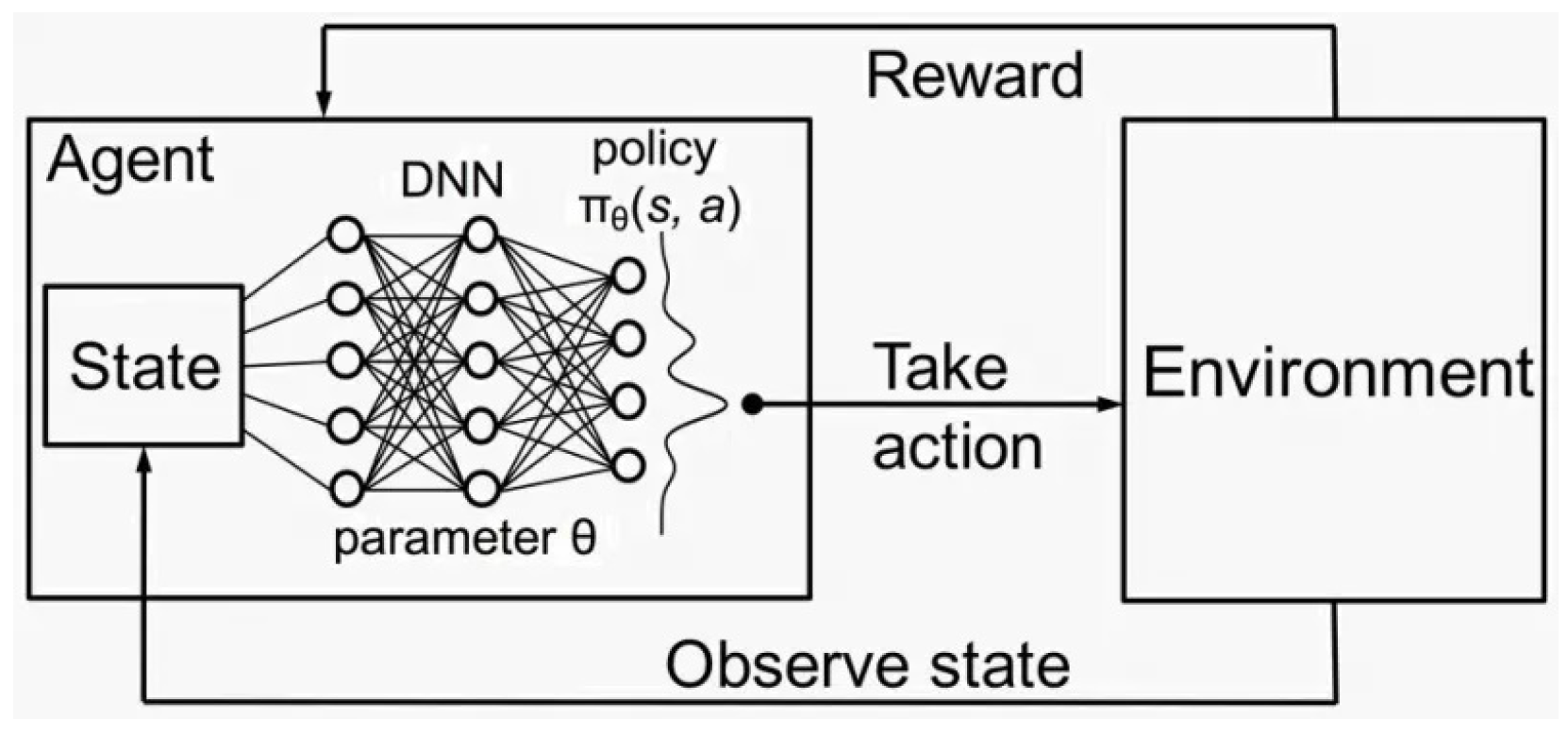
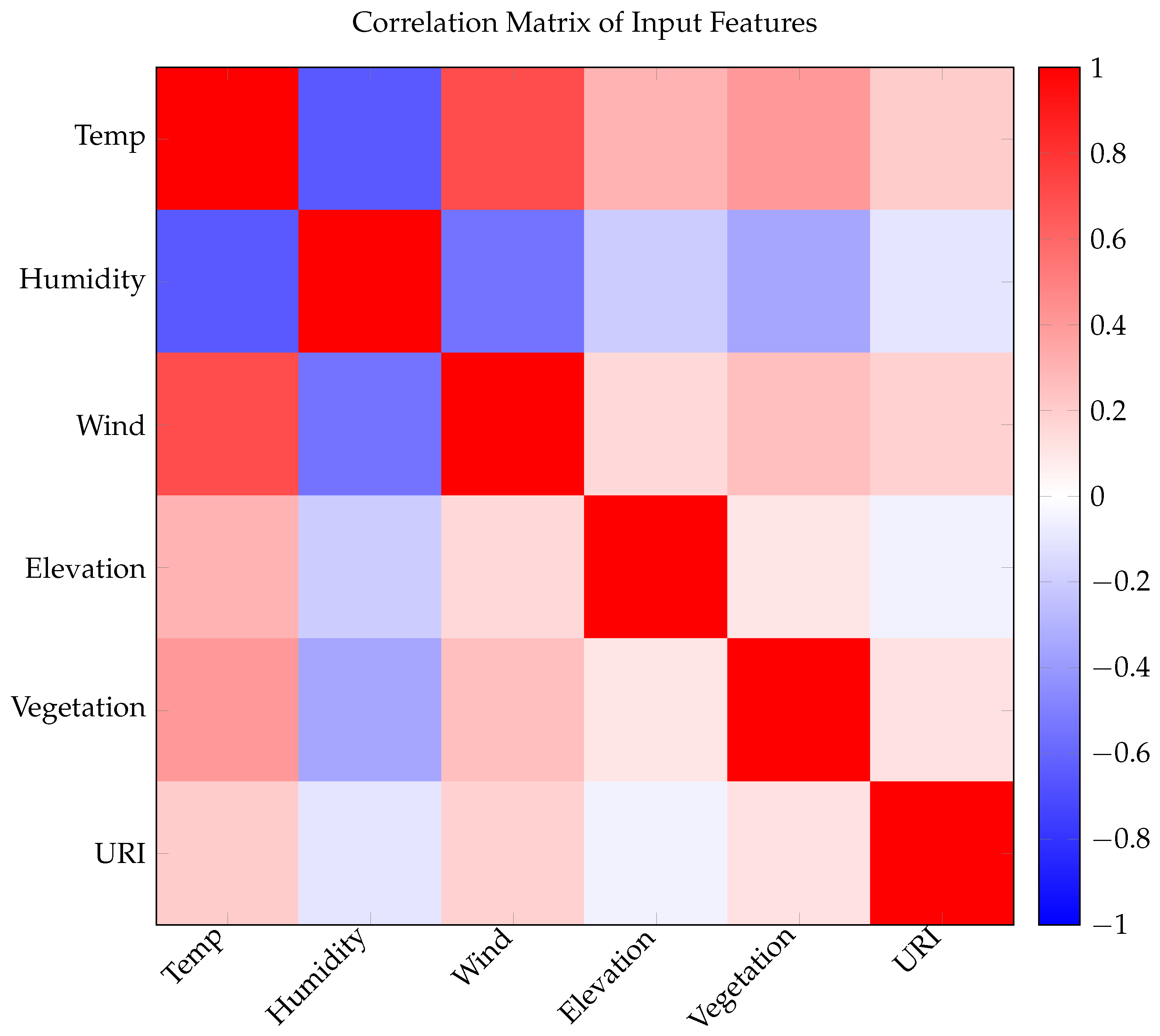
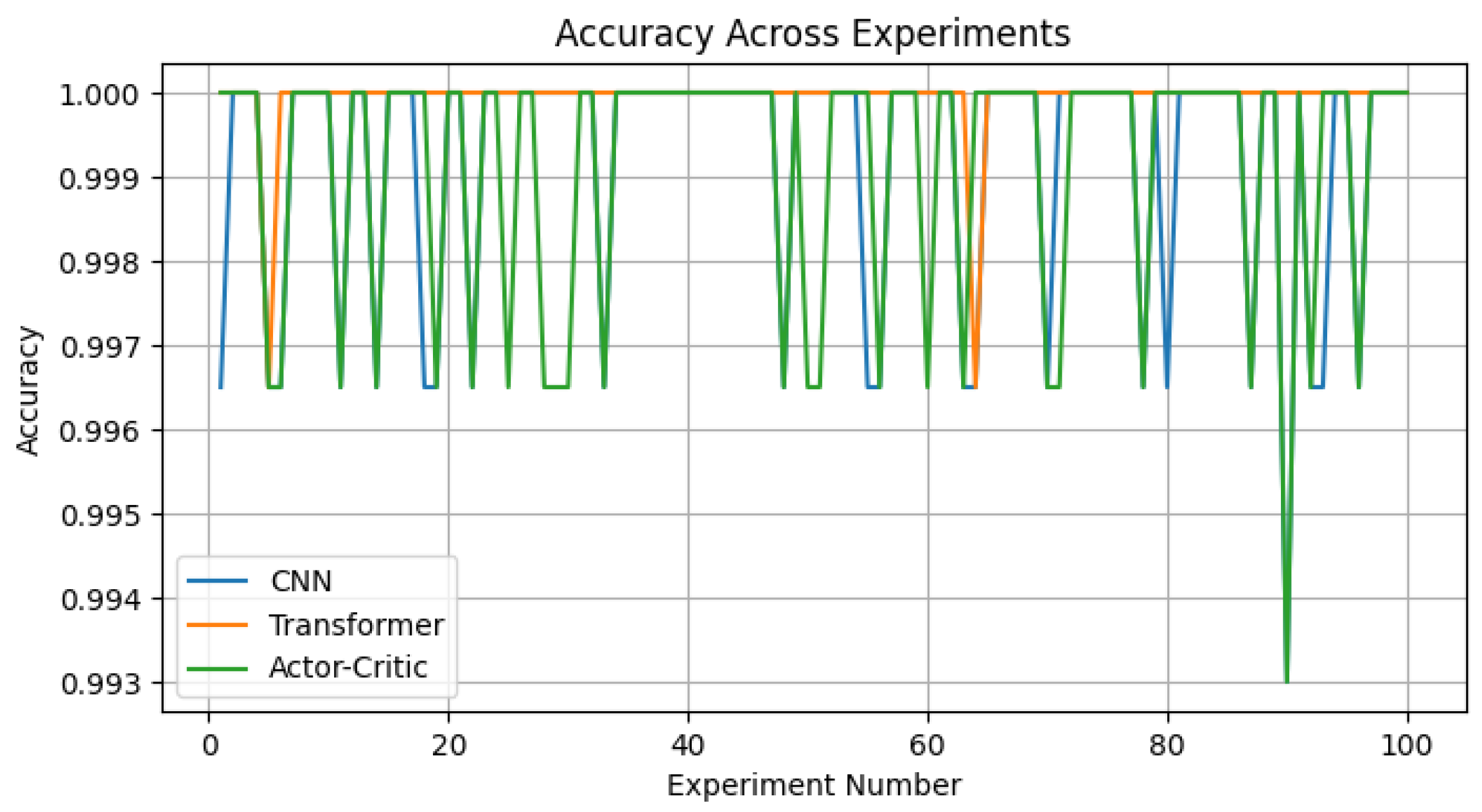
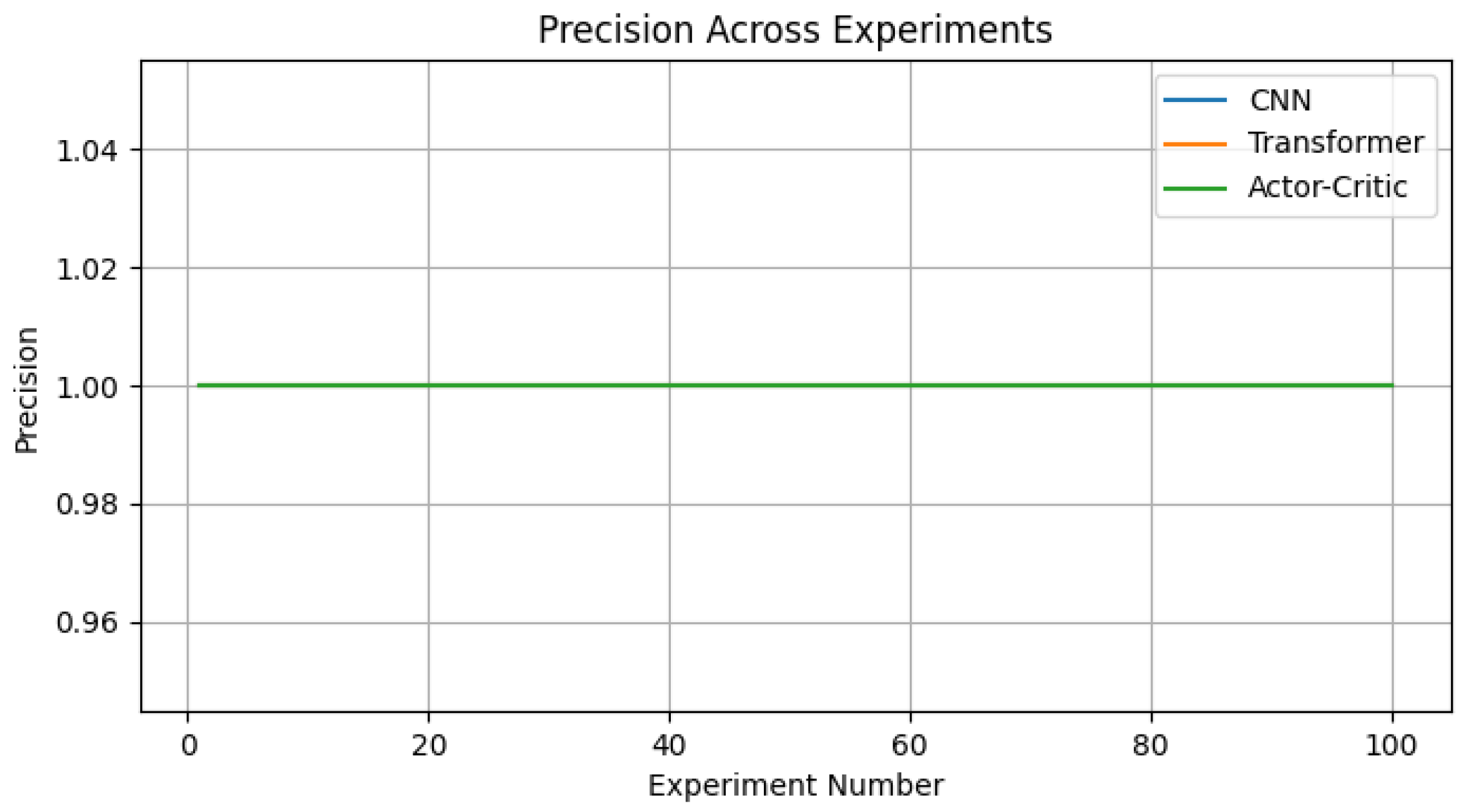
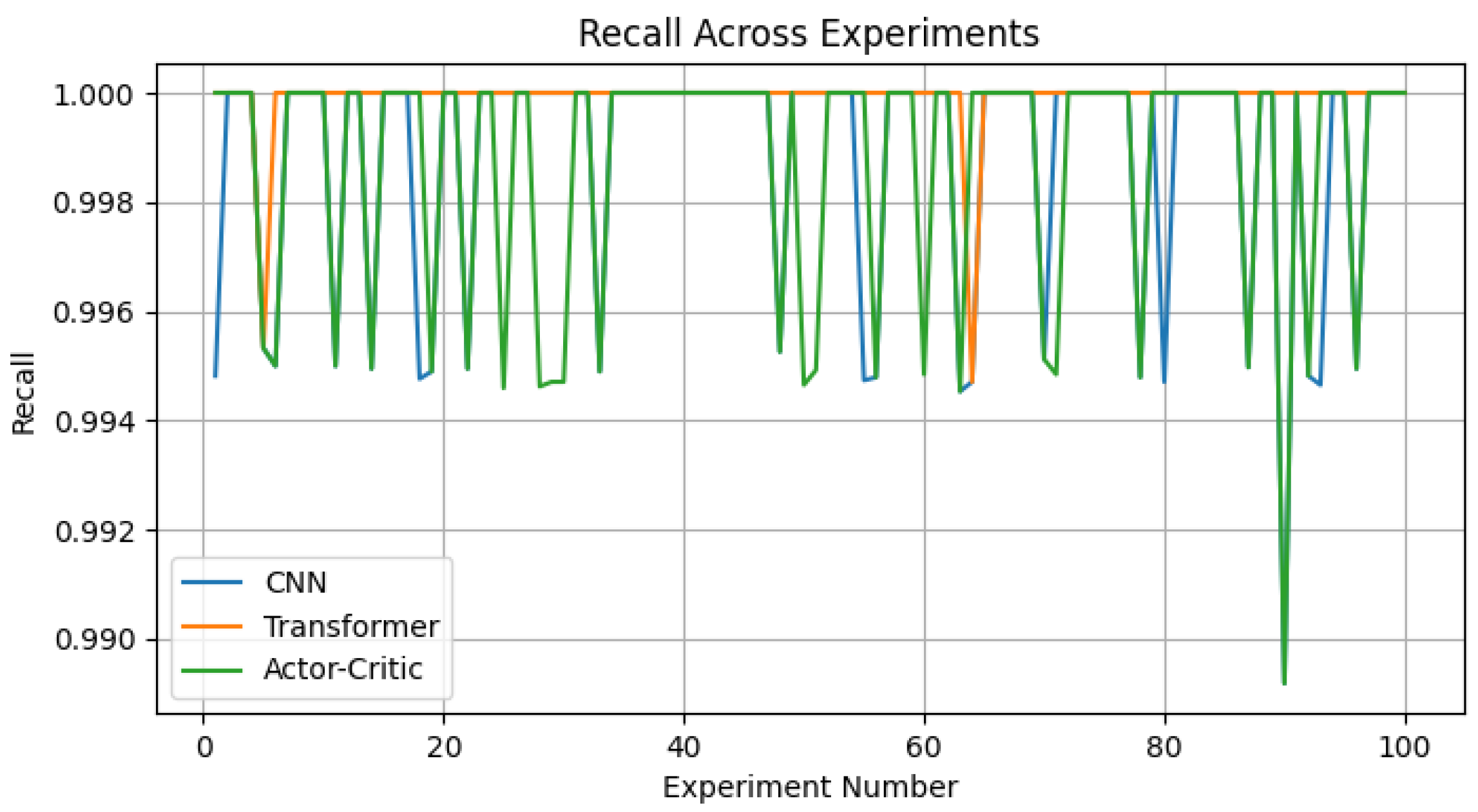
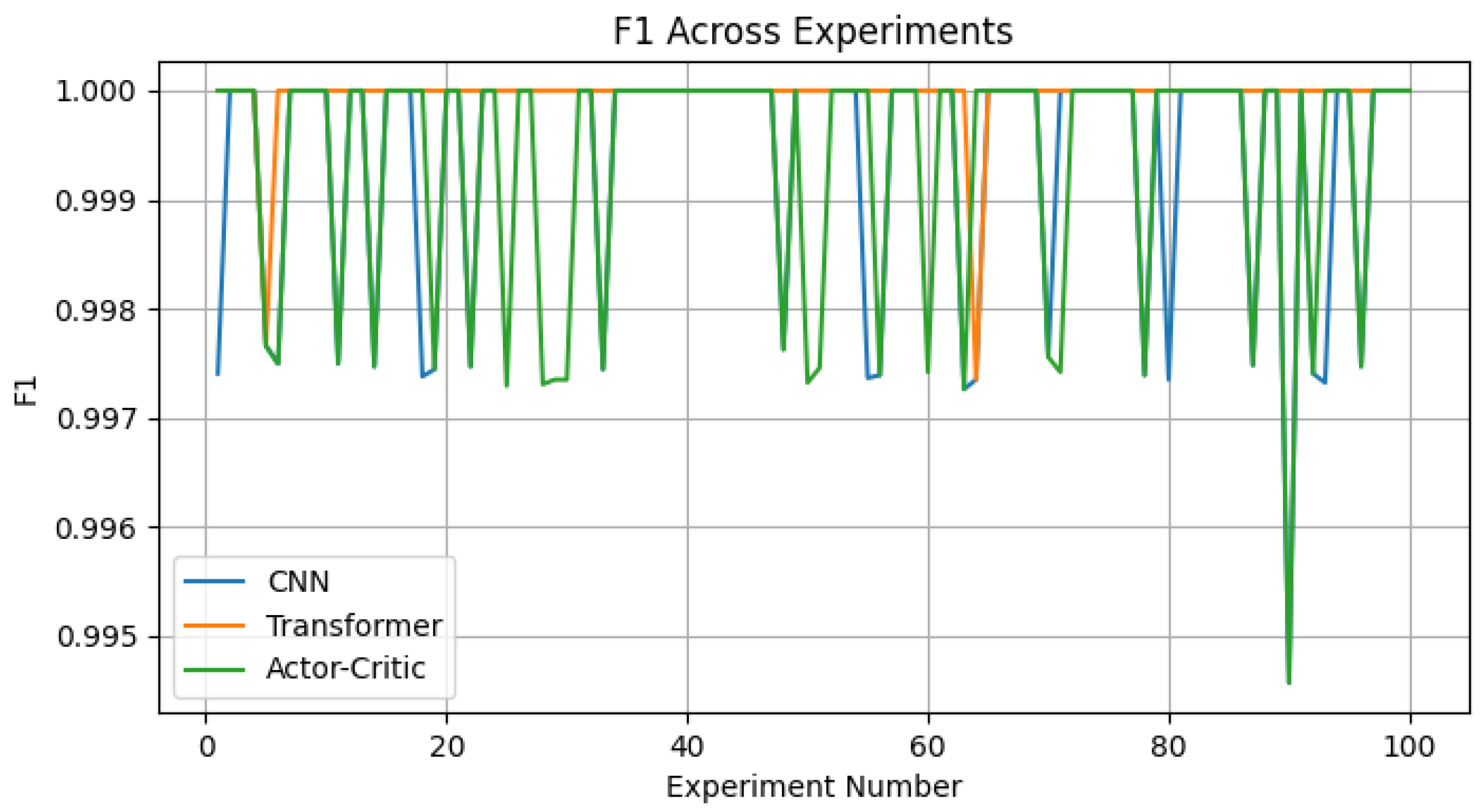
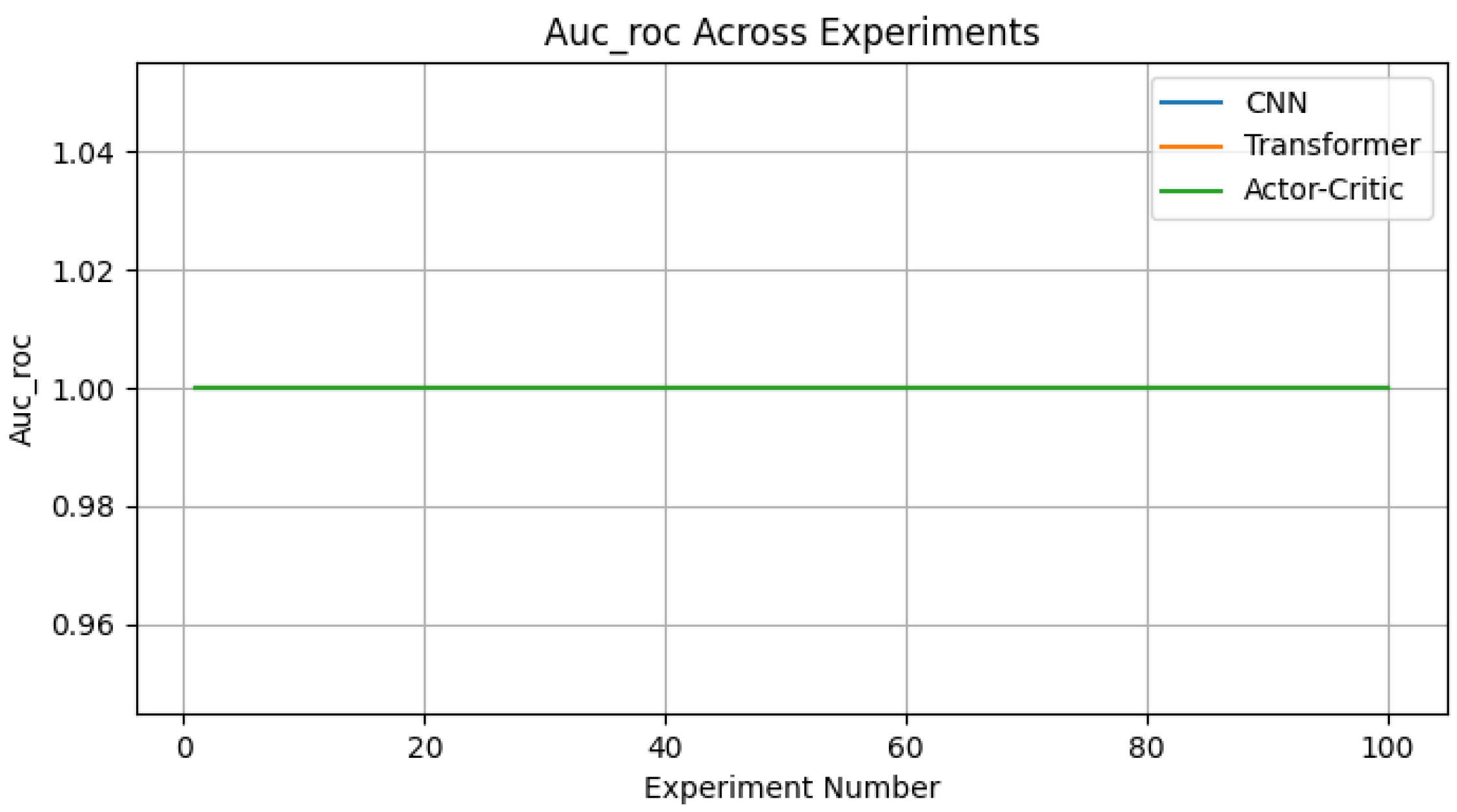
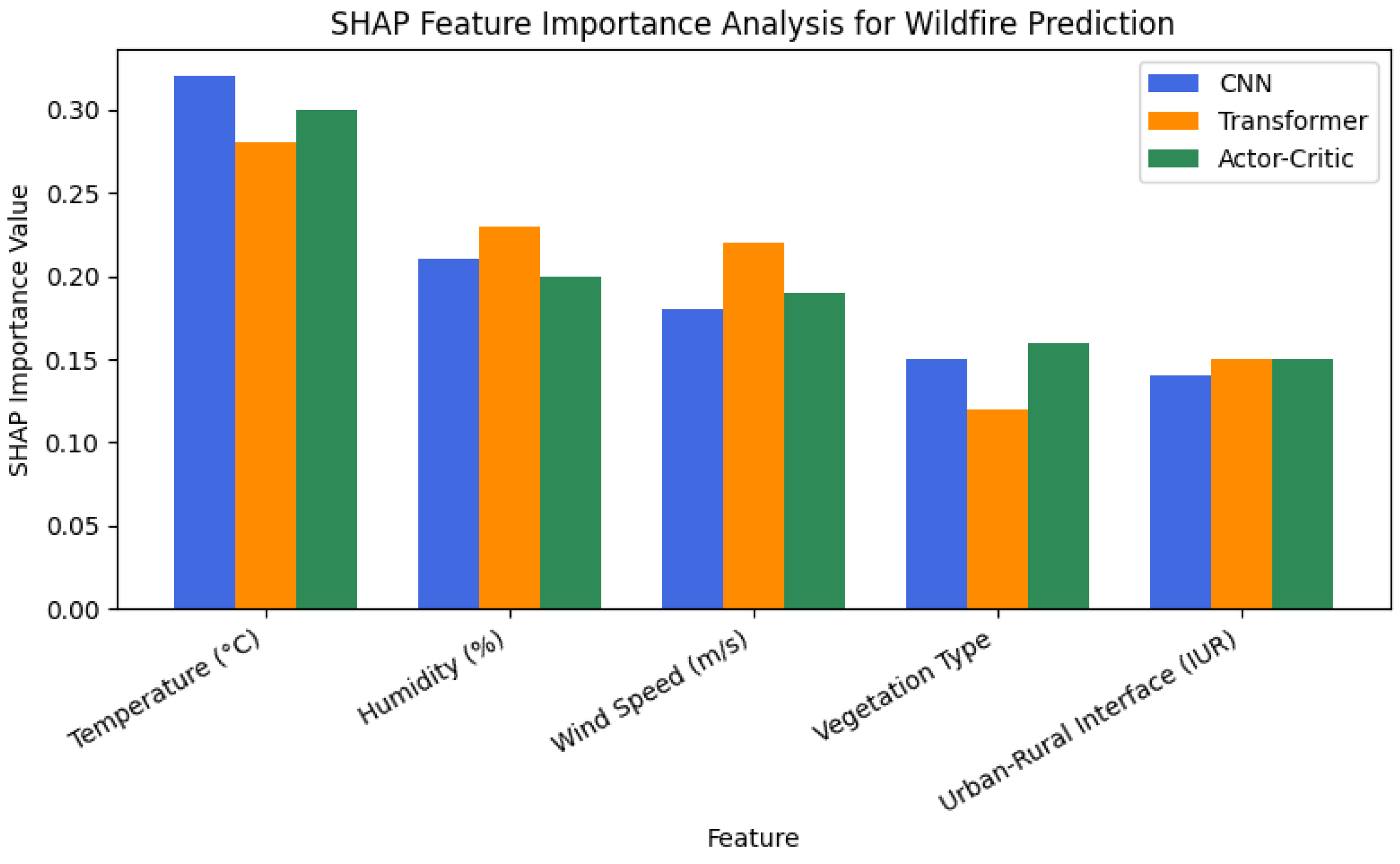
| Impact Area | Consequences |
|---|---|
| Environmental | Deforestation, biodiversity loss, soil degradation, carbon emissions |
| Health | Respiratory diseases, fatalities, psychological stress in affected populations |
| Economic | Property loss, infrastructure damage, suppression costs |
| Ecosystem Services | Disruption of water cycles, loss of pollinators, habitat fragmentation |
| Method | Application | Advantage |
|---|---|---|
| CNN | Image-based fire detection | High spatial accuracy |
| RNN | Time-series fire prediction | Captures temporal trends |
| Transformer | Large-scale fire modeling | Efficient in long-term prediction |
| Year | Temperature (°C) | Humidity (%) | Wind (m/s) | Elevation (m) | Vegetation Type | URI | Probability |
|---|---|---|---|---|---|---|---|
| 2000 | 28.5 | 40 | 3.2 | 500 | Forest | Yes | 0.8 |
| 2001 | 32.1 | 35 | 4.1 | 450 | Shrubland | No | 0.7 |
| 2002 | 30.0 | 45 | 2.8 | 600 | Grassland | Yes | 0.85 |
| ⋯ | ⋯ | ⋯ | ⋯ | ⋯ | ⋯ | ⋯ | ⋯ |
| 2023 | 33.5 | 38 | 5.0 | 700 | Forest | No | 0.9 |
| Model | Accuracy | Precision | Recall | F1-Score | AUC-ROC |
|---|---|---|---|---|---|
| CNN | 0.9992 | 1.0000 | 0.9989 | 0.9994 | 1.0000 |
| Transformer | 0.9995 | 1.0000 | 0.9993 | 0.9997 | 1.0000 |
| Actor–Critic | 0.9990 | 1.0000 | 0.9987 | 0.9993 | 1.0000 |
| Model | TN | FP | FN | TP |
|---|---|---|---|---|
| CNN | 88 | 0 | 0 | 198 |
| Transformer | 88 | 0 | 0 | 198 |
| Actor–Critic | 88 | 0 | 1 | 197 |
| Model | Dataset | Accuracy | F1-Score | AUC-ROC |
|---|---|---|---|---|
| CNN | Validation | 0.9991 | 0.9993 | 1.0000 |
| Test | 0.9992 | 0.9994 | 1.0000 | |
| Transformer | Validation | 0.9994 | 0.9996 | 1.0000 |
| Test | 0.9995 | 0.9997 | 1.0000 | |
| Actor–Critic | Validation | 0.9989 | 0.9992 | 1.0000 |
| Test | 0.9990 | 0.9993 | 1.0000 |
Disclaimer/Publisher’s Note: The statements, opinions and data contained in all publications are solely those of the individual author(s) and contributor(s) and not of MDPI and/or the editor(s). MDPI and/or the editor(s) disclaim responsibility for any injury to people or property resulting from any ideas, methods, instructions or products referred to in the content. |
© 2025 by the authors. Licensee MDPI, Basel, Switzerland. This article is an open access article distributed under the terms and conditions of the Creative Commons Attribution (CC BY) license (https://creativecommons.org/licenses/by/4.0/).
Share and Cite
Vidal-Silva, C.; Pizarro, R.; Castillo-Soto, M.; Ingram, B.; de la Fuente, C.; Duarte, V.; Sangüesa, C.; Ibañez, A. A Comparative Study of a Deep Reinforcement Learning Solution and Alternative Deep Learning Models for Wildfire Prediction. Appl. Sci. 2025, 15, 3990. https://doi.org/10.3390/app15073990
Vidal-Silva C, Pizarro R, Castillo-Soto M, Ingram B, de la Fuente C, Duarte V, Sangüesa C, Ibañez A. A Comparative Study of a Deep Reinforcement Learning Solution and Alternative Deep Learning Models for Wildfire Prediction. Applied Sciences. 2025; 15(7):3990. https://doi.org/10.3390/app15073990
Chicago/Turabian StyleVidal-Silva, Cristian, Roberto Pizarro, Miguel Castillo-Soto, Ben Ingram, Claudia de la Fuente, Vannessa Duarte, Claudia Sangüesa, and Alfredo Ibañez. 2025. "A Comparative Study of a Deep Reinforcement Learning Solution and Alternative Deep Learning Models for Wildfire Prediction" Applied Sciences 15, no. 7: 3990. https://doi.org/10.3390/app15073990
APA StyleVidal-Silva, C., Pizarro, R., Castillo-Soto, M., Ingram, B., de la Fuente, C., Duarte, V., Sangüesa, C., & Ibañez, A. (2025). A Comparative Study of a Deep Reinforcement Learning Solution and Alternative Deep Learning Models for Wildfire Prediction. Applied Sciences, 15(7), 3990. https://doi.org/10.3390/app15073990







